The Coronavirus Hit Germany And The UK Just Days Apart But The Countries Have Responded Differently. Here’s How.
From a first case to thousands of deaths: A timeline of how Boris Johnson and Angela Merkel’s governments handled COVID-19.
The journalists at BuzzFeed News are proud to bring you trustworthy and relevant reporting about the coronavirus. To help keep this news free, become a member and sign up for our newsletter, Outbreak Today.
When the novel coronavirus reached the UK and Germany, both governments assessed the risk as low and said they were well prepared. But a detailed analysis by BuzzFeed News of the two countries’ responses since the first cases were reported at the end of January shows how the two countries adopted different approaches in those crucial early weeks.
While Angela Merkel’s government moved quickly to scale up testing and contact tracing of those infected, Boris Johnson’s initial strategy, on the basis of the recommendations of his top scientific advisers, continued to focus primarily on hygiene recommendations while schools, mass gatherings, work, and leisure activities continued.
Nearly three months since their first positive cases, Germany has conducted more than 1.3 million tests and contact tracing remains central to its strategy. The UK has carried out fewer than 335,000 tests and all but dropped attempts to aggressively trace contacts. About 3,000 people have died so far in Germany. More than 10,000 have died in the UK.
This timeline reveals how British and German leaders communicated about this crisis at every step, and shows that they prepared differently and rolled out key measures to fight the virus at different times. Decisions delayed by just a few days may have had a significant impact.
Germany
- January 27: Germany registers its first case. Health authorities in the state of Bavaria say a 33-year-old man contracted the virus from a colleague who was visiting from China. It is believed to be the first case of human-to-human transmission in Europe.
Health minister Jens Spahn says the patient is being isolated and his contacts traced.
The risk posed by the disease remains “very low”, according to an official assessment. - January 29: Information pages are published by the government, and infographics with hygiene tips explaining how to wash hands and sneeze are promoted on social media and released in multiple languages.
- February 3: Lufthansa announces it’s extending a suspension of flights to China until the end of the month, after a passenger had a suspected case of the coronavirus disease. Twelve people have so far tested positive for the virus, according to data published by the newspaper Zeit.
- February 13:
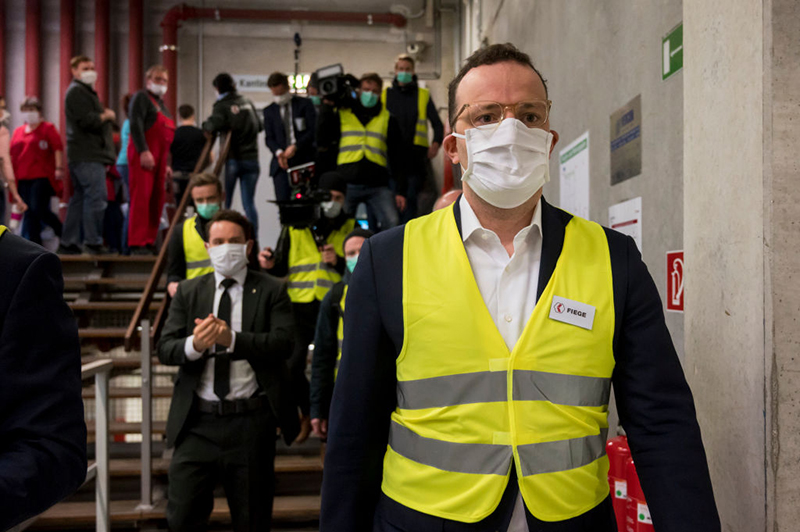
At a meeting of EU health ministers, Spahn tells reporters that travel restrictions to and from China, such as those imposed by Italy, will not be taken unilaterally.
Travellers from China to the states of Bavaria and Hesse will be asked about any stays in hot spots and contact they may have had with potentially infected people. - February 26:

Following an outbreak of cases in North Rhine-Westphalia, the district of Heinsberg temporarily closes schools and kindergartens as well as public swimming pools and libraries. Several sporting events in the region are also cancelled.
With transmission of the disease now taking place within communities and cases spreading across Europe, the German government says it is a “new situation”. - February 28:

A coronavirus crisis response team led by the German health and interior ministries adopts a series of guidelines, including requirements on passengers travelling from major hot spots to report their health status. Enhanced police checks around borders are introduced.
The government also announces plans to centralise procurement and stockpiling of essential equipment.
An international travel trade show scheduled for the following month in Berlin is cancelled as part of a risk assessment of major events.
“We take the situation seriously,” health minister Spahn says. He indicates that Germany is ramping up testing. “It’s better to have more tests than too few,” he says.
People showing symptoms are advised to call their doctor or the helpline, and not go to hospital and sit in waiting rooms, as the government continues to issue updates on social media. - February 29: All parliamentary groups are informed of fast-moving developments, and a meeting of EU health ministers is called by Spahn and the health ministers of Italy and France. “The situation has changed significantly in many European countries in the past few days and hours,” Spahn tweets.
- March 2: Germany begins the month with 140 positive cases, with infections detected in 10 of the country’s 16 regions. The RKI raises its threat level to “moderate”.
Germany has the capacity to run 7,115 tests a day that week, data published by the RKI shows. By the end of the week, it will have done 87,863 tests since the beginning of the crisis. Contact tracing is central to the government’s approach.
A senior virologist advising the German government says “this illness is a mild illness”.
Health minister Spahn says cancelling all mass events and shutting businesses is not appropriate, and closing borders is not necessary. The health minister warns, however, that eventually "every day life will have to be restricted a bit". - March 4: Amid warnings of shortages, the coronavirus crisis response team declares that procuring personal protective equipment (PPE) is of “extraordinary urgency”. The government temporarily bans the export of PPE, a move that will later be reversed after an intervention by the EU.
Spahn tells the Bundestag that the epidemic is now a global pandemic. Talking about the possible cancellation of events and school closures, the health minister says the safety of the population will come before economic interests. - March 9: Germany reports its first two deaths — both in North Rhine-Westphalia — as the total number of cases surpasses 1,200.
Data published by the RKI shows the country has the capacity to run 31,000 tests a day. 127,457 tests are carried out that week.
The government begins to talk about flattening the curve on social media. - March 10: The government recommends the cancellation of all events with more than 1,000 people and advises against travel to Italy. Because of Germany’s federal setup, the implementation of the recommendations are up to each individual region. The government also announces that it will be urgently procuring intensive care equipment centrally. Visits to government departments and parliament are cancelled, and work begins to lift a ban on Sunday trading.
“Our primary goal remains to slow down the spread of the coronavirus. The slower the virus spreads, the better our health care system can handle it,” Spahn says.
For the first time in the football league’s history, the Bundesliga says that some matches will be played behind closed doors, following guidelines issued by some regions.
There are confirmed COVID-19 cases in all of Germany’s 16 states. - March 11: German chancellor Angela Merkel makes her first major intervention, warning that the country is fighting against a virus for which there is no vaccine nor therapy. An estimated 60%–70% of the population could become infected, she warns, adding: “It’s about winning time.”
She urges people to abide by social distancing recommendations. Look each other in the eye “for a second longer” rather than shake hands, she says. - March 12: Donald Trump announces a travel ban to the US from most of Europe. The president provided no advance warning to America’s European allies, and the move is criticised by most European governments.
- March 13: The Bundesliga announces it is suspending the league, following similar measures in most of Europe.
The government places an order for 10,000 ventilators.
All states announce that schools and kindergartens across the country will close. - March 15:
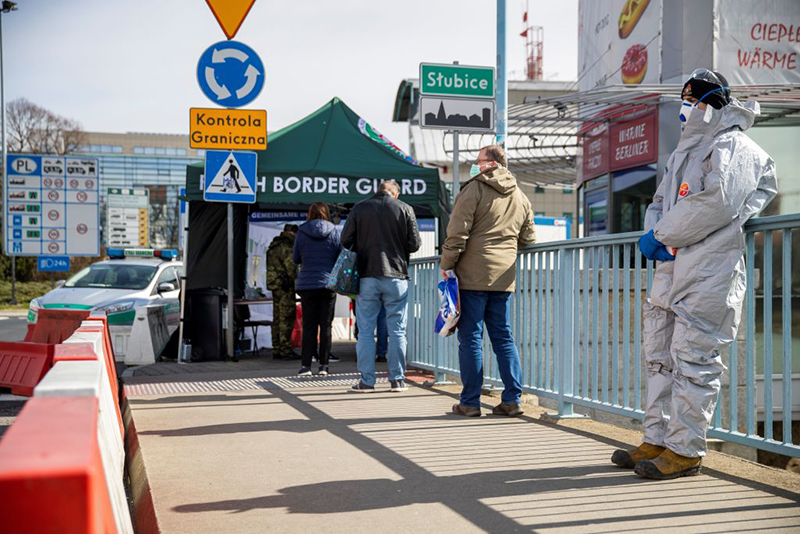
Temporary border controls are introduced. Two days later, the EU announces it will be recommending the closure of the entire bloc’s borders. - March 16: Merkel announces a series of measures to restrict social contacts, including the closure of most nonessential retail outlets. Venues such as clubs, bars, and playgrounds will be shut, and gatherings in churches, mosques, and synagogues banned. Merkel describes the measures as unprecedented in the country's recent history. "There have never been measures like this in our country before. They are far-reaching, but at the moment they are necessary," the chancellor says.
Some states, including Bavaria, have already introduced similar measures.
The government advises against all nonessential foriegn travel. - March 17: The RKI increases the threat level to “high”. Data published by the institute shows the country has the capacity to run 64,725 tests a day. 348,619 tests are carried out that week.
9,373 people have tested positive for COVID-19 and 24 people have died. - March 18:
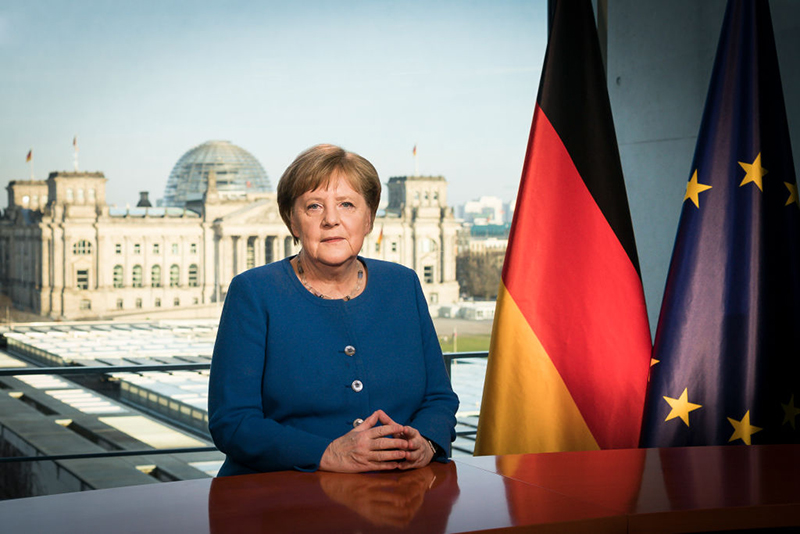
Merkel addresses the nation on television, which she had previously only done for her New Year’s speech. "The situation is serious. Take it seriously. Not since German reunification — no, not since World War II has our country faced a challenge that depends so much on our collective solidarity," she says. - March 22:

The government tightens its lockdown measures by introducing a nine-point plan. It includes strict social distancing, a ban on outdoor gatherings of more than two people, except when of the same household, as well as private parties. Movements are restricted to essential reasons of work, exercise, shopping for food, and emergencies. Restaurants and hairdressers are asked to close. The new rules will stay in place for at least two week, chancellor Merkel says.
Shortly afterwards, Merkel goes into self-isolation after coming into contact with a doctor who had tested positive for COVID-19. - March 23: The number of positive cases passes 31,500, with 144 dead. Testing capacity hits 103,515 per day. Some 361,000 tests are carried out that week.
- March 26: Foreign minister Heiko Maas says Germany will take 47 coronavirus patients from Italy. Germany had also sent the country 1 million face masks.
- March 29: A report published by Google using data from products like Google Maps shows that mobility is significantly down: -71% in retail locations, -51% for places like grocery markets and pharmacies, -49% for parks, -68% for transit stations, and -39% for workplaces.
- March 31: The eastern city of Jena asks people to wear face masks on public transport and when shopping, the first place in the country to do so.
- April 1: Lockdown measures are extended to April 19, Merkel says.
The chancellor says the vast majority of people are following the rules, and some effects from the measures can be seen. But it is too early to say what will happen after Easter, she adds. “I know it's tough, but it saves lives,” says Merkel. - April 2: At least 2,300 doctors and nurses have contracted the coronavirus, according to the RKI. Overall, 84,244 people have tested positive for the virus by April 1 and 1,114 have died.
Testing capacity hits 116,655 tests a day. Nearly 400,000 tests will be carried out during the week, according to official RKI figures, with some estimates from government advisers suggesting the actual figure could be even higher and closer to half a million. - April 3: Intensive care units are being expanded to 40,000 and ventilation units to 30,000. Before the crisis, there were 28,000 intensive care beds nationwide, including 20,000 with ventilation. These were occupied on average at a rate of 70%–80%.
- April 6: Merkel wishes Boris Johnson a speedy recovery.
Merkel says the European Union is facing "the greatest test since it was first founded".
The government announces it will introduce measures to allow seasonal workers to enter the country. It says its centralised procurement system is working well, but more is needed to be done to ensure that all facilities, including care homes, have all the PPE they need. - April 7: German media reports that Merkel negotiated a deal directly with President Xi Jinping of China over delivery of PPE.
- April 8: An update published by the RKI shows that Germany has conducted more than 1.3 million tests since the crisis began. Although it now carries out some 500,000 tests a week, contact tracing remains central to the approach and is regarded as one of the most important tools to slow the spread of the disease.
- April 9: Merkel tells reporters at a press conference that the numbers "give rise to cautious hope". She says: “The curve is flattening slightly. And the number of those infected is going slightly down.” The chancellor warns that it was important to not let up during the Easter weekend.
- Merkel says stricter restrictions may not be needed, but she cautions that it is important to move forward in small steps because it is not yet known what effect easing restrictions will have. She announces that the government will soon have a discussion on how to proceed and is waiting for recommendations from the German National Academy of Sciences due next week.
- April 11: A total of 117,658 people have tested positive — and 2,544 have died, according to data collected by the RKI, while 57,400 people have so far recovered from the disease.
The institute will start work next week on large-scale antibody testing, with the first results expected in May.
UK
- January 31: Chief medical officer Chris Whitty announces the first two UK cases.
Public Health England says it is tracing people who have been in contact.
Whitty says: “The NHS is extremely well prepared and used to managing infections, and we are already working rapidly to identify any contacts the patients had to prevent further spread.” - February 2: Matt Hancock launches a public information campaign about the coronavirus.
“Basic hygiene such as washing our hands regularly and using tissues when we cough and sneeze can play an important role in minimising the spread of viruses like this,” he says. - February 4: Dominic Raab urges Britons in China to leave — the UK is the first country to do so.
- February 10:
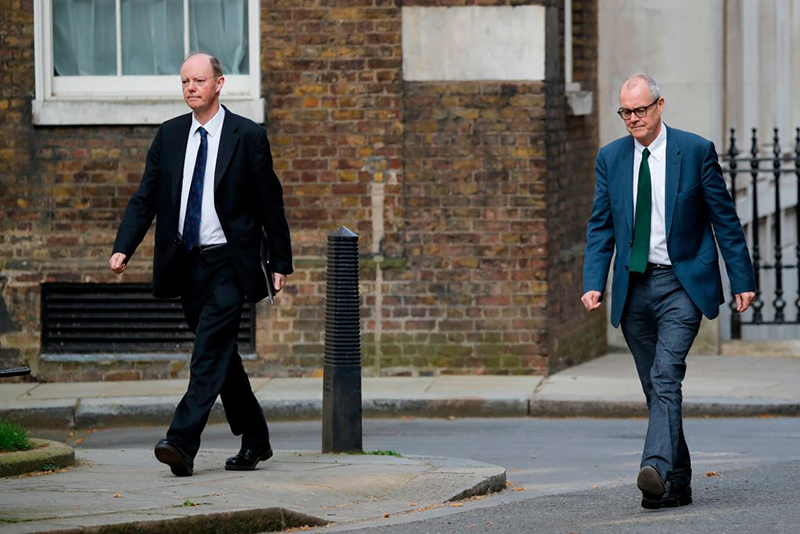
Chris Whitty (above, left) says eight people have tested positive for coronavirus in the UK out of 1,114 tests.
Matt Hancock says “the incidence or transmission of novel coronavirus constitutes a serious and imminent threat to public health”. - February 12: First patient tests positive in London.
- February 13: Chris Whitty outlines the UK’s strategy to contain and delay any outbreak of the virus to the summer. He says Britons do not need to change their behaviour other than taking sensible precautions.
“We have a strategy that relies on four tactical aims. The first is to contain, the second is to delay, the third is to do the science and the research, and the fourth is to mitigate so that we can actually brace the NHS,” he says. - February 14: Public Health England contacts 200 people who attended the UK Bus Summit at the QEII Centre in Westminster, amid fears they may have been in contact with the virus.
London Fashion Week opens. - February 16: 3,109 tests carried out in the UK — nine positive.
- February 21: The NHS begins testing people at home in London. The approach will be rolled out across the UK in the coming weeks.
- February 25: Matt Hancock says people returning from quarantine zones in Northern Italy should self-isolate.
- February 28: First British death, in Japan.
The UK now has 20 cases, including the first person to catch the virus in Britain. - February 29: Health minister Edward Argar says Chris Whitty’s advice is “clear there is no reason or need for schools en masse to close” at the moment, as three more test positive.
- March 2: Boris Johnson holds an emergency Cobra meeting and says an outbreak across the UK is “likely”.
“We have agreed a plan so that if and when it starts to spread, as I’m afraid it looks likely it will, we are in a position to take the steps necessary to contain the spread of the disease as far as we can and to protect the most vulnerable,” the prime minister says.
Nicola Sturgeon says: “We’re expecting perhaps 50% or as much as 80% of the population would be infected during that epidemic.” - March 3:
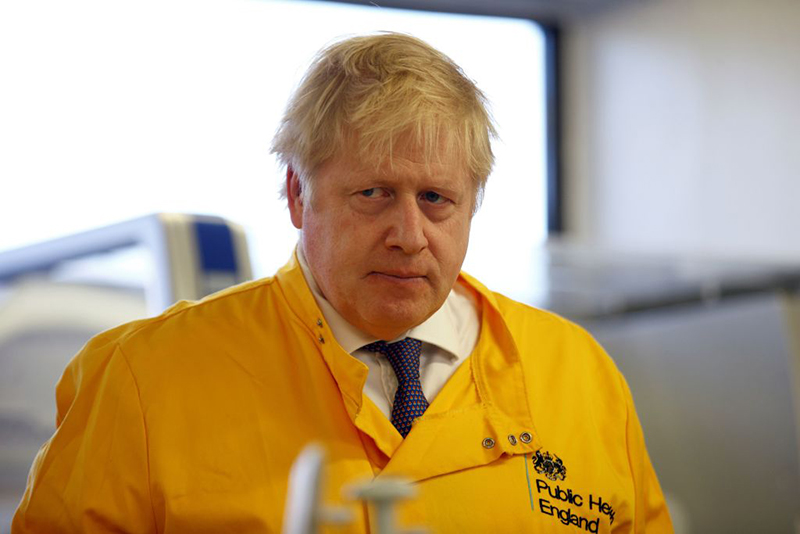
51 people in the UK have now tested positive out of 13,911 tested.
Johnson says “I shook hands with everybody” during a visit to a hospital. - March 4: Chris Whitty says there is “probably” onward transmission in the UK and an epidemic is “likely, not definite”.
“We probably do have some onward transmission here in the UK. Now we are on the borderline between containing and delaying. At this point in time we think it is likely, not definite, that we will move into onward transmission and an epidemic here in the UK.” - March 7: Boris Johnson goes to Twickenham to watch England play rugby, shaking hands with people in the crowd around him.
206 people have tested positive for COVID-19 in the UK. More than 21,000 people have been tested for the virus. - March 8: A UK government official briefs ITV News that the more stringent approach followed by Italy involves “populist measures” that “aren’t any use”.
- March 9: Boris Johnson’s first press conference with Chris Whitty and chief scientific adviser Patrick Vallance.
The PM says the best advice is to wash your hands, and says the UK is still in the contain stage but is preparing to move to the delay stage.
Asked why the UK wasn’t taking more draconian steps, he said: “We mustn’t do things with no or limited benefits.”
Public Health England says the NHS will be brought in to help on testing, doubling daily testing capacity from 2,000 to 4,000. - March 10: Health minister Nadine Dorries tests positive.
- March 12: The UK moves from the “contain phase” to the “delay phase”.
Johnson calls it “the worst public health crisis for a generation” and says “many more families are going to lose loved ones before their time”. But Whitty says social distancing measures will not be introduced yet. Those with mild symptoms are told to stay at home for seven days. Scotland bans gatherings of more than 500 people, but England does not. Schools remain open. - March 13:
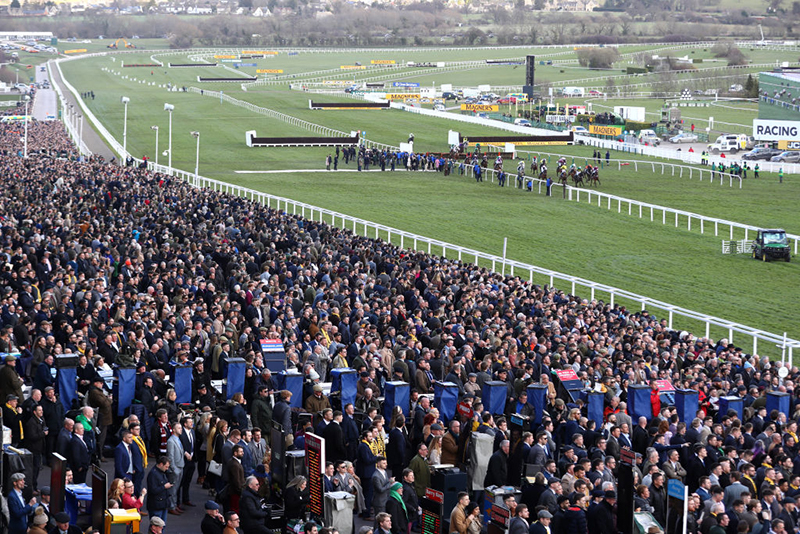
The Cheltenham horse racing festival concludes. More than 250,000 people attended.
Chief scientific adviser Patrick Vallance suggests in an interview with the BBC that the UK’s goal is to achieve “herd immunity”.
“If you suppress something very, very hard, when you release those measures it bounces back, and it bounces back at the wrong time. Our aim is to try to reduce the peak, broaden the peak, not suppress it completely; also, because the vast majority of people get a mild illness, to build up some kind of herd immunity so more people are immune to this disease and we reduce the transmission, at the same time we protect those who are most vulnerable to it.”
But that evening, Downing Street says mass gatherings will be banned the following week, in a U-turn on the previous day’s statements. - March 16: Transport minister Grant Shapps rejects criticism that the UK has not gone far enough, insisting it is focussing on scientific advice rather than “doing things that just sound good”, in an apparent reference to more stringent measures taken by other countries.
Hours later, a report by Imperial College reveals the UK only realised "in the last few days" that attempts to "mitigate" the impact of the coronavirus pandemic would not work, and that it needed to shift to a strategy to "suppress" the outbreak.
The WHO says its key message is “test, test, test”. Overall only 44,105 people have been tested in the UK, but Whitty insists the government is “scaling up” testing.
In the evening, Boris Johnson holds the first of Downing Street’s daily press conferences and unveils tougher advice, telling Britons to avoid all unnecessary contact and travel, and to stay away from pubs and theatres.
If one person in a household shows systems, there should be 14 days of self-isolation for the rest of the household. Those who can work from home should. - March 17: The UK advises against all nonessential travel abroad.
- March 18:
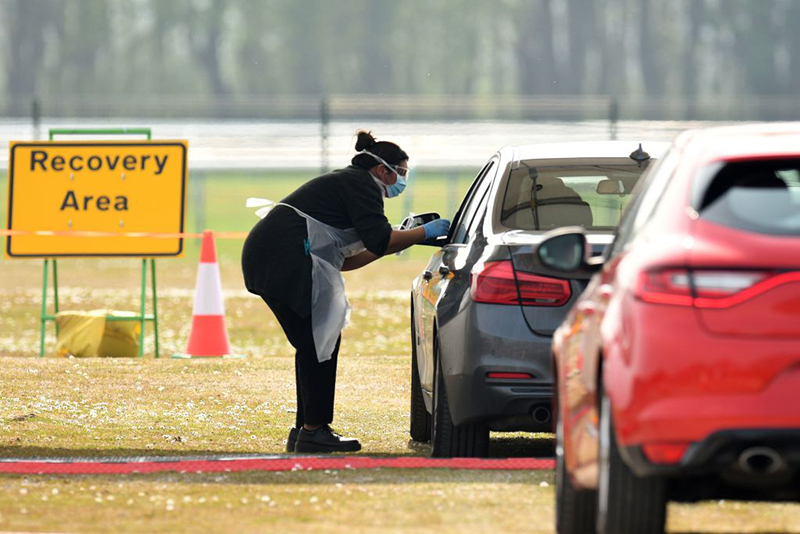
The government announces all schools across the UK will close indefinitely from Friday, March 20.
The UK death toll rises to 104.
Boris Johnson tells Parliament the government will ramp up testing to 25,000 tests a day. - March 19: Boris Johnson claims “we can turn the tide within the next 12 weeks”. He raises the prospect of a possible rollout of an antibody test “as simple as a pregnancy test”.
- March 20: Boris Johnson orders pubs, clubs, restaurants, and other entertainment and leisure venues to close.
- March 22: Following reports that people are ignoring social distancing advice, Johnson warns he could have to introduce tougher measures.
- March 23:
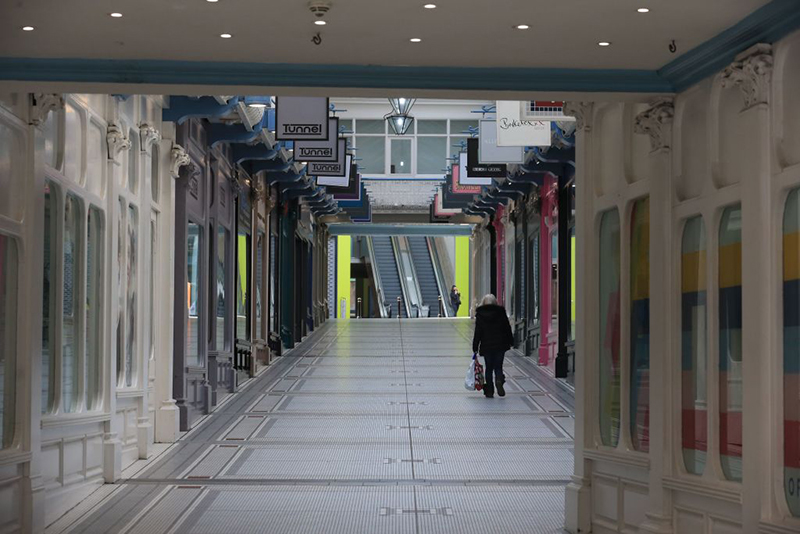
Boris Johnson announces a UK-wide lockdown, with people only allowed to leave their homes for one of four reasons: for work, essential shopping, medical reasons, or exercise. - March 25: Chris Whitty blames a global shortage of chemicals for the UK’s lack of testing, when asked why Britain is behind other countries.
“We are going up from 5,000 to 10,000 tests per day, to 25,000, hopefully very soon up to 250,000 per day,” he says.
Public Health England’s Sharon Peacock says the UK could roll out a mass antibody test within days. But Whitty rejects this: “I do not think, and I want to be clear, that this is something that we’ll suddenly be ordering on the internet next week.” - March 26: Death toll now 578. 11,658 people across the UK have tested positive.
Deputy chief medical officer Jenny Harries rejects the WHO’s advice to “test, test, test”, suggesting it is aimed at less economically developed countries and is “not appropriate” for the UK at this stage of the outbreak. - March 27: Boris Johnson and Matt Hancock test positive for COVID-19. Chris Whitty also self-isolates after developing symptoms.
- March 29: The UK fails to reach its goal of 10,000 daily tests.
A report published by Google using data from products like Google Maps shows mobility is significantly down: -85% in retail locations, -46% for places like grocery markets and pharmacies, -52% for parks, -75% for transit stations, and -55% for workplaces, while Britons spend more time at home. - April 1: Boris Johnson says testing will “unlock the puzzle” to beating the virus, following intense criticism from the media. The Conservative-supporting Daily Telegraph and Daily Mail both criticised the government’s lack of testing.
It emerges just 2,000 NHS staff have been tested. - April 2:
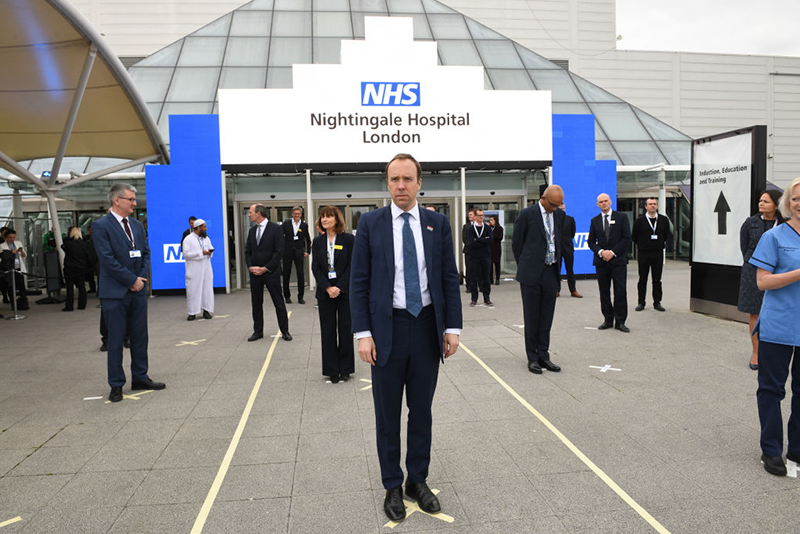
Matt Hancock sets a target of 100,000 tests a day by the end of April.
He admits the UK has been unable to match the level of testing in countries such as Germany because of its smaller diagnostics industry and a shortage of swabs and chemicals. - April 5:
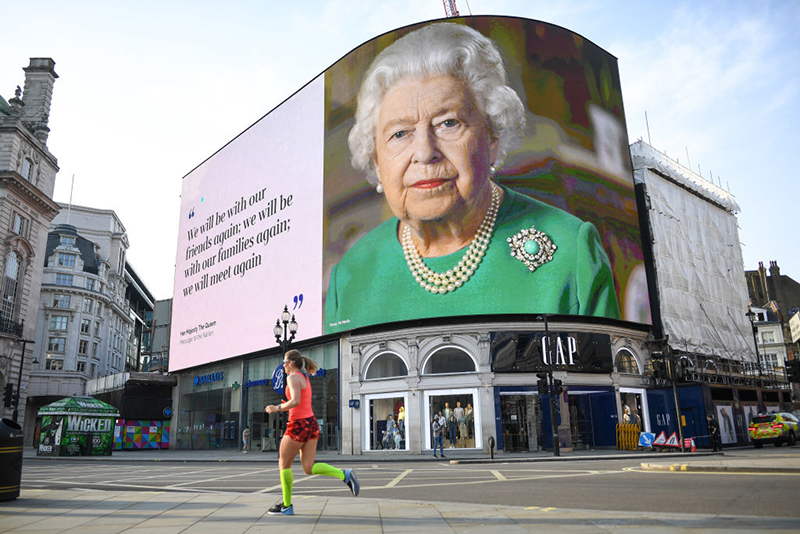
Boris Johnson is admitted to hospital. In a televised address to the nation, Queen Elizabeth calls for “self-discipline and resolve” to defeat the coronavirus. - April 6: Boris Johnson is moved to intensive care.
- April 7: Chris Whitty says the UK has a “lot to learn” from other countries such as Germany on testing.
- April 8: 938 people die in a single day, taking the total death toll to 7,097. The UK reaches 14,000 tests a day.
- April 9: Dominic Raab signals that the UK lockdown will be extended, as Johnson is moved out of intensive care after his condition improved.
Germany’s army donates 60 ventilators to the UK. - April 10: The government announces a plan to ensure that all health workers get PPE, amid persistent reports of continued shortages.
- April 11: A total of 78,991 people have tested positive. Of those hospitalised, 9,875 have died. The Department of Health says 334,974 tests have been conducted so far.



